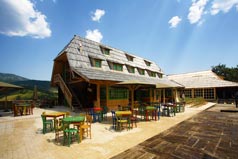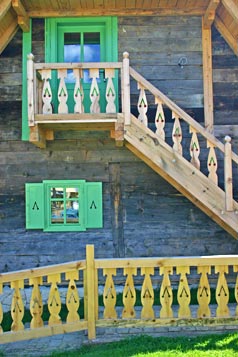Ethnic parks

Ethnic parks came into being through conservation activities aimed at preserving authentic examples of folk architecture or through modern building work done in the distinctive ethnic styles of certain geographical regions. In contrast to authentic Serbian villages, the ethnic parks are aimed solely at tourists or comprised of buildings of cultural and historical importance, and nobody actually lives in them.
They are painstakingly recreated Serbian villages of one or two centuries ago, most commonly built from wood and stone. Accommodation is provided in rooms with rural motifs and furniture, and food is served in ethnic restaurants offering traditional dishes.
In the yards there are barns and other outbuildings which were part of the old village way of life, and there are also items such as horse-drawn carriages, brandy stills and agricultural equipment, all displayed outdoors. Some ethnic parks also have wine cellars, horse paddocks and permanent museum displays.

On one of the slopes of Mokra Gora, on Mećavnik hill, the Drvengrad ethnic park was built, the creative vilayet of well-known film director Emir Kusturica, containing restaurants, a cinema and a gallery.
In Tršić, the birthplace of Vuk Stefanović Karadžić, near Loznica, there is an ethnic park with a memorial house, buildings with folk architecture and visitor facilities.
The Divljakovac ethnic village was built on the slopes of the Bukulja mountain and comprises seven outbuildings over 200 years old, which have been turned into two-bed and five-bed apartments.
The Beli Kamen ethnic village is located not far from Prokuplje, at 950 m above sea-level, and has all the usual facilities for overnight stays, food and recreation.
The archaeological and ethnic park in the village of Ravna, which is 8 km north of Knjaževac and close to the ancient fortress of Timacum Minus, with a research station in the village school, has a reconstructed village household from the late 19thcentury and early 20th
